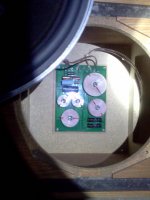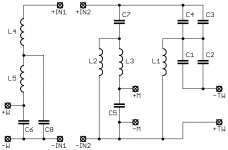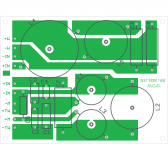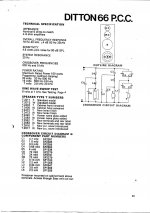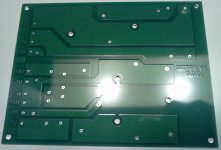mixMZ - Happy New Year.
You seem about right with your 5% PP/95% Lytic mix.
I tried 3uf PP (10% of 30uf total required) and this was too much. I then went for 2.2uf PP (7.3%) and this was better. The small amount of PP adds guts to the sound, fills it out and is more dynamic.
I have a pair of 1.5uf PP (5%) on order, I would be suprised if these were any better than the 2.2uf as these are sounding very good mixed with 26.7uf of Visaton LL lytic. Still, never say never. 🙂
You seem about right with your 5% PP/95% Lytic mix.
I tried 3uf PP (10% of 30uf total required) and this was too much. I then went for 2.2uf PP (7.3%) and this was better. The small amount of PP adds guts to the sound, fills it out and is more dynamic.
I have a pair of 1.5uf PP (5%) on order, I would be suprised if these were any better than the 2.2uf as these are sounding very good mixed with 26.7uf of Visaton LL lytic. Still, never say never. 🙂
I've just helped rebuild some spendor BC1's. Celestion HF 1300 I beleive. Beautiful but a slightly strident edge. So slight it can be ignored. I guess a cap change could make it sound nicer. I will leave that to the owner. The Rotel looks interesting. I often use a RA931. It is a better amp than many 3 times it's price. BC1 is likke a bumble bee. It can not possibly fly and yet.
Last edited:
Update

The parts have been fitted to the new boards and then located in the bottom chamber, behind the ABR unit.
Burning everything in now before any critical listening.
I ended up with a mixture for the 30uf series cap of about 7.5% Ansar Supersound PP & the remainder using a pair of Visaton LL electrolytics, so thats the bundle of three in the lower right corner.

The parts have been fitted to the new boards and then located in the bottom chamber, behind the ABR unit.
Burning everything in now before any critical listening.
I ended up with a mixture for the 30uf series cap of about 7.5% Ansar Supersound PP & the remainder using a pair of Visaton LL electrolytics, so thats the bundle of three in the lower right corner.
Hey Ken,
Wow that looks good. Far better than my cardboard crossovers, haha. I really need to get them onto more proper boards.
I'm excited to hear about your findings with the new boards, I am sure you will find the separation of the inductors to be a positive improvement to the sound.
I have a little update myself. My Alcaps still have not shown up - no idea what's going on there. I e-mailed Falcon to inquire about if they were somehow missed as an order.
Anyway, I do have some 7uF Alcaps laying around here so I decided I'd give those a try on top of the 24uF Elcaps. I wish I had some 4uF electrolytics lying around to try out, but I don't so the original ones will have to stay in there for now.
I did some comparing against the Celestion with the 24uF and the PIO bypassed. I preferred the voicing of the 24uF with the 7uF Alcap, it sounded more natural to my ears and the midrange seemed "fuller". Perhaps this is because the midrange filter is now crossing over at the appropriate point due to the MF500? Around the crossover point is where I noticed the most difference, though, so I can only imagine this is why.
Wow that looks good. Far better than my cardboard crossovers, haha. I really need to get them onto more proper boards.
I'm excited to hear about your findings with the new boards, I am sure you will find the separation of the inductors to be a positive improvement to the sound.
I have a little update myself. My Alcaps still have not shown up - no idea what's going on there. I e-mailed Falcon to inquire about if they were somehow missed as an order.
Anyway, I do have some 7uF Alcaps laying around here so I decided I'd give those a try on top of the 24uF Elcaps. I wish I had some 4uF electrolytics lying around to try out, but I don't so the original ones will have to stay in there for now.
I did some comparing against the Celestion with the 24uF and the PIO bypassed. I preferred the voicing of the 24uF with the 7uF Alcap, it sounded more natural to my ears and the midrange seemed "fuller". Perhaps this is because the midrange filter is now crossing over at the appropriate point due to the MF500? Around the crossover point is where I noticed the most difference, though, so I can only imagine this is why.
Hi Jeffrey
Bit of a mixed bag with the new x-over boards fitted.
When I had the parts strewn accross my floor as a lash up the sound was very dynamic, I thought maybe too much so. When I soldered the same parts into the board, which will have made better connections than the multiple terminal blocks I had in place, the life drained from the mid range. The only thing I changed was the wiring, I started with the cheap QED(original) wire both in the cabinate and from the binding posts to the external x-overs, I used some similar cheap wire from x-over to amp (tri-wired) and it all sounded fine. When I moved the parts on to the board I used better quality speaker leads and used Black Rhodium silicon sleeved wires internally, but the dynamics were poor.
I took the speakers to a local bake off on Saterday and in a larger room with greater volume used this was still the case, I have lost something along the way.
One thing I did notice was the treble is really clean now. Moving the coils appart did improve the mid range a bit by reducing resonance but only by a small amount, 2/3rds of it is still there. I'm running out of ideas.
A chap at the bake off uses a programable DSP in his active system, he is local to me and is going to bring it round and set it up with my x-over values. This will give me an idea as to whether an active x-over will work with the 66's and also if the original x-over design is the source of all the problems.
Meanwhile I am going to switch back to the cheaper cable to see if that gives me some of the dynamics back.
Several people at the bake off, who do some serious DIY designing of valve amps phono stages and speaker systems, suggested trying paper in oil instead of PP in the mid range mix. Maybe worth a try.
Nothing so far has given a clean midrange which I could live with long term, including the original Elcaps. They were warm and less than transparent, the more you clean things up the more obvious the resonance becomes. If you over damp trying to get rid of it, you suck the life out of the sound, it's a bit of a merry go round.
Fingers crossed the active approach works.
Bit of a mixed bag with the new x-over boards fitted.
When I had the parts strewn accross my floor as a lash up the sound was very dynamic, I thought maybe too much so. When I soldered the same parts into the board, which will have made better connections than the multiple terminal blocks I had in place, the life drained from the mid range. The only thing I changed was the wiring, I started with the cheap QED(original) wire both in the cabinate and from the binding posts to the external x-overs, I used some similar cheap wire from x-over to amp (tri-wired) and it all sounded fine. When I moved the parts on to the board I used better quality speaker leads and used Black Rhodium silicon sleeved wires internally, but the dynamics were poor.
I took the speakers to a local bake off on Saterday and in a larger room with greater volume used this was still the case, I have lost something along the way.
One thing I did notice was the treble is really clean now. Moving the coils appart did improve the mid range a bit by reducing resonance but only by a small amount, 2/3rds of it is still there. I'm running out of ideas.
A chap at the bake off uses a programable DSP in his active system, he is local to me and is going to bring it round and set it up with my x-over values. This will give me an idea as to whether an active x-over will work with the 66's and also if the original x-over design is the source of all the problems.
Meanwhile I am going to switch back to the cheaper cable to see if that gives me some of the dynamics back.
Several people at the bake off, who do some serious DIY designing of valve amps phono stages and speaker systems, suggested trying paper in oil instead of PP in the mid range mix. Maybe worth a try.
Nothing so far has given a clean midrange which I could live with long term, including the original Elcaps. They were warm and less than transparent, the more you clean things up the more obvious the resonance becomes. If you over damp trying to get rid of it, you suck the life out of the sound, it's a bit of a merry go round.
Fingers crossed the active approach works.
Hmm interesting Ken.
You sure are willing to go further than I am with these speakers. I'm at a point where I'm just about done tinkering with them.
Where do you detect the resonance in the midrange? Is it in the upper, mid or lower bandwidth in the midrange? Reason I ask is I wonder if it has something to do with the 5kHz crossover point. As I understand it, the reason that high of an x-over point was picked was because it was just at the tip of the MF/MD500s frequency response and also juuust barely at a good point for the HF2000. With the Seas, you could very well lower that point down toe about 3.5kHz and it would work just fine as the Seas is flat at that point. I wonder if moving the crossover point down some would improve dynamics and take some strain of the mid dome driver.
You sure are willing to go further than I am with these speakers. I'm at a point where I'm just about done tinkering with them.
Where do you detect the resonance in the midrange? Is it in the upper, mid or lower bandwidth in the midrange? Reason I ask is I wonder if it has something to do with the 5kHz crossover point. As I understand it, the reason that high of an x-over point was picked was because it was just at the tip of the MF/MD500s frequency response and also juuust barely at a good point for the HF2000. With the Seas, you could very well lower that point down toe about 3.5kHz and it would work just fine as the Seas is flat at that point. I wonder if moving the crossover point down some would improve dynamics and take some strain of the mid dome driver.
If I think about it, I probably am going too far. Best to just stick with what worked best and live with the flaws - all speakers have them.
The resonance is made in the mid filter but is at the crossover point and when the stock circuit is used and all the elements are connected electricaly, it can also be heard through the tweeter. Seperating the elements leaves it just in the mid range.
The MD500 driver falls off a cliff at 4.5kHz but the earlier MF500 is flat to 7Khz and then rolls off slower than the MD. It's the compromise that was made when they increased the power handling.
Yes the Seas will allow a lower x-over point.
The mid is also on its stops at the lower end as well, the bass unit can be crossed over much higher, it is crossed at 2khz in a 2-way but that is pushing it.
The resonance is made in the mid filter but is at the crossover point and when the stock circuit is used and all the elements are connected electricaly, it can also be heard through the tweeter. Seperating the elements leaves it just in the mid range.
The MD500 driver falls off a cliff at 4.5kHz but the earlier MF500 is flat to 7Khz and then rolls off slower than the MD. It's the compromise that was made when they increased the power handling.
Yes the Seas will allow a lower x-over point.
The mid is also on its stops at the lower end as well, the bass unit can be crossed over much higher, it is crossed at 2khz in a 2-way but that is pushing it.
Not related with Ditton 66, but I wanted to share my experience with Ditton 332. Year ago I refurbed a busted 332 and replaced all Elcap capacitors with film caps. Used Claritycap esa for tweeter, rest was Erse. Somehow I never satisfied with the final sound. It was like whole balance between drivers were messed up. I alter crossover one more time with Russion Pio caps. Better but still something was missing.
I always follow this thread, and read your precious information about caps and how they alter sound of your beautiful 66's. I was curious. Finally removed all caps and used Alcap lythics.
After three days....
Now I have evil smile on my face while listening my lovely 332's.

I always follow this thread, and read your precious information about caps and how they alter sound of your beautiful 66's. I was curious. Finally removed all caps and used Alcap lythics.
After three days....
Now I have evil smile on my face while listening my lovely 332's.
Finally removed all caps and used Alcap lythics.
After three days....
Now I have evil smile on my face while listening my lovely 332's.

Yes just replacing the old lytics with Alcaps does work well.
I found that Visaton and Mundorf Lytics sound even better and they are all cheap as chips. 😉
I redesigned the Celestion 66 Xover PCBs (PCC version) to allow Bi-Amp'd configuration. The PCBs are extra thick (94 mils) and use the original inductors and caps. Connections are 18GA solder pads for an improvement over the old wiring harness that relied on point contacts and thin wires. I have eight blank Xover PCBs remaining for $35 each plus shipping. Reply to m.malherbe@att.net if interested. Or I am glad to E-mail the Eagle layout files if you want to order your own.
Attachments
Redesigned Celestion 66 crossover.
Attached picture of PCB.
To accompany new PCB I used:
Bi-Amp Speaker Terminal Cup Gold Insulated Binding Post, Part # 260-246 from Parts Express and replaced the brown ceramic caps.
Attached picture of PCB.
To accompany new PCB I used:
An externally hosted image should be here but it was not working when we last tested it.
Bi-Amp Speaker Terminal Cup Gold Insulated Binding Post, Part # 260-246 from Parts Express and replaced the brown ceramic caps.
Attachments
Hi!
So did everyone settle for electrolytics for the midrange after all?
I'm about to do my very own 66's and I've already got the Alcaps. Right now there are SCR caps instead of the old Elcaps which still measure fine by the way! I've tested them at the inputs of my Quad 303 - between preamp and amp - and there was absolutely no difference to the sound or to the level for that matter.
So did everyone settle for electrolytics for the midrange after all?
I'm about to do my very own 66's and I've already got the Alcaps. Right now there are SCR caps instead of the old Elcaps which still measure fine by the way! I've tested them at the inputs of my Quad 303 - between preamp and amp - and there was absolutely no difference to the sound or to the level for that matter.
Best electrolytics for dittons are red visaton, alcaps sounding not clean, mundorf are better but visaton are clearly winner.
mikemb - Re your PCB layout, the position of your coils is far from optimum and bound to lead to interaction between them.
To all - I have spent many hundreds of hours on the 66 crossovers and tried EVERYTHING suggested on this thread and others and quite a few things of my own. This includes Seas Tweeters PP caps of many makes and values and Lytics of many makes and values. I have re orientaed and repositioned coils and moved the booards away from the bass driver magnet and tri wired etc etc.
It would take many pages just to sum up my experimenting. If anyone is intrested it is all layed out on my website here: Index
And of course has the details of the final soloution which worked best for my system set up.
To all - I have spent many hundreds of hours on the 66 crossovers and tried EVERYTHING suggested on this thread and others and quite a few things of my own. This includes Seas Tweeters PP caps of many makes and values and Lytics of many makes and values. I have re orientaed and repositioned coils and moved the booards away from the bass driver magnet and tri wired etc etc.
It would take many pages just to sum up my experimenting. If anyone is intrested it is all layed out on my website here: Index
And of course has the details of the final soloution which worked best for my system set up.
I have measured inductance of side by side coils and noted only small changes. The sort of real life changes car improvement gadgets bring, that is less than 1% usually. The next thing I have never tested so can only pass on the folklaw. It is said the big magnets of speakers matter more. Some take the crossover outside the box and report a different sound. As we all know different is often mistaken for better. However if the magnet is a factor this will be a different sound. It might be about inductor Q also. To be fair one car improvement gadget was the inline filter. In the days of carburetors they did stop surge and that did slightly improve fuel use ( 2% ? ). I notice now they have a healthy market protecting the injectors with no mention of fuel use. They were called Filter King. Mostly they were sold as a fuel saver in the past. I suspect this was discovered by chance and was thought to be easier to sell than clean fuel. Sad really as a fuel filter is worth every penny.
I recently paid someone to design a technically excellent speaker which possibly started from a bad point. We used state of the art drive units if a salesman. It became like a friend of mine who seems to take 24 pills mostly to offset other pills. In the end we went to find drive units that didn't need the pills. Paper units and ribbon tweeters. Just two first order crossovers. Not 100% ideal but somehow more like real music. If you like what LS3/5A and Linn Kan suggest might be possible. I intend to do the final correction actively one day. KEF had the CUBE to do the same.
Many people who design amplifiers will get very involved in arguements about damping factors. As far as I can see most crossovers minimise the importance of that. The Dynaco A25 and many Royd designs being the exception as the bass unit has no filtering. To me this is why active speakers always sound different and often worse. It seems to me there is an optimum damping factor. I could imagine if the Qts is high that would suit active better.
I recently paid someone to design a technically excellent speaker which possibly started from a bad point. We used state of the art drive units if a salesman. It became like a friend of mine who seems to take 24 pills mostly to offset other pills. In the end we went to find drive units that didn't need the pills. Paper units and ribbon tweeters. Just two first order crossovers. Not 100% ideal but somehow more like real music. If you like what LS3/5A and Linn Kan suggest might be possible. I intend to do the final correction actively one day. KEF had the CUBE to do the same.
Many people who design amplifiers will get very involved in arguements about damping factors. As far as I can see most crossovers minimise the importance of that. The Dynaco A25 and many Royd designs being the exception as the bass unit has no filtering. To me this is why active speakers always sound different and often worse. It seems to me there is an optimum damping factor. I could imagine if the Qts is high that would suit active better.
Nigel pearson - A change in inductance on closely positioned coils is only one part of the equation, Troels has some good info on coil orientation on his site and shows his measeurments, for anyone interested it is linked here: Placement of coils in crossover networks
Noise or degraded signal due to electro magnetic interference is also a variable to consider.
The coils on the 66 are mounted only a couple of inches from the bass drivers large magnet, and as you rightly say, is as much of a concern. I reorientad the coils and placed the cross over in the lower compartment. There was an improvement, but I will admit it was very small compared to getting the caps right, tri wiring made a more noticeable change for instance.
Noise or degraded signal due to electro magnetic interference is also a variable to consider.
The coils on the 66 are mounted only a couple of inches from the bass drivers large magnet, and as you rightly say, is as much of a concern. I reorientad the coils and placed the cross over in the lower compartment. There was an improvement, but I will admit it was very small compared to getting the caps right, tri wiring made a more noticeable change for instance.
That is very true in amplifers. Douglas Self devotes half a page to it.
The caps are a funny thing. It's worth trying all sorts. The mains class X2 caps are fine and very cheap. What makes a good mains cap make a good high frequency cap. Same with electrolytic. High voltage is almost the same as high quality. I have never tried paper. The Rifa mains are that, alas not so cheap.
Jerry Bloomfield at Falcon near to me has excellent caps at very good prices. I forget what we used in the end. His inductors also.
The caps are a funny thing. It's worth trying all sorts. The mains class X2 caps are fine and very cheap. What makes a good mains cap make a good high frequency cap. Same with electrolytic. High voltage is almost the same as high quality. I have never tried paper. The Rifa mains are that, alas not so cheap.
Jerry Bloomfield at Falcon near to me has excellent caps at very good prices. I forget what we used in the end. His inductors also.
Thanks for the links Qwin, I very much like the idea of completely separating each of the three sections electrically and physically. I'm not certain of the actual amount of interaction between the inductors but none would be the best amount.
Hi Qwin. I'm interested in your tri-wiring outcome. I have my 66 Xovers outside the cabinet so they are very accessible but I have not read many positive reviews on bi/tri-wiring so have not gone down this path. Is the "noticeable change" you mention for the better or is it just a variation to the sound you are hearing. You're not meaning tri-amping are you?
Reggie
Reggie
- Home
- Loudspeakers
- Multi-Way
- Celestion 66 needs mid-range
